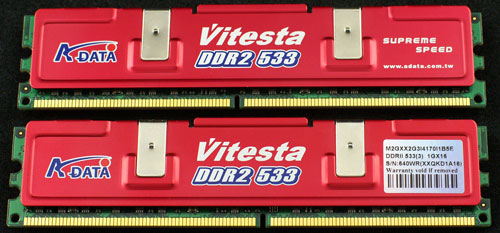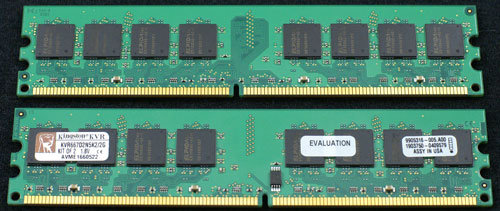Conroe Buying Guide: Feeding the Monster
by Gary Key & Wesley Fink on July 19, 2006 6:20 AM EST- Posted in
- Motherboards
Value DDR2
Not everyone is prepared to pay $450 for the very best DDR2. Without comparing performance of lower-priced DDR2 it is also not possible to recommend whether high-performance DDR2 represents a good value for you. Looking at what was available in the market, we compiled a list of modules that appeared to be a representative cross-section of the 2GB kit value segment. With prices ranging from around $120 to $180 for a 2GB kit, these DDR2 modules are less than half the price of our high-performance selections.
The real question, of course, is where you can take these low-cost DDR DIMMs. We ran all the DIMMs at the highest DDR2 speeds and the fastest memory timings we could achieve on a standard Core 2 Duo test platform. The results were truly surprising.
A-Data Vitesta DDR2-5300

A-Data is one of the largest memory application suppliers in the world and their Vitesta DDR2-533 kit performed extremely well in our testing from both a timing and voltage aspect. The quality of the heat spreaders and memory PCB is excellent..
Corsair Value Select DDR2-667

Corsair was able to provide us their ValueSelect 2GB kit. Although Corsair is mainly known for their XMS series of high performance memories they also provide a very good price to performance offering in their ValueSelect series. While the modules do not include any heat spreaders, we did not notice any thermal issues during our testing that required the use of higher voltages to reach our reported numbers.
Kingston Value Ram DDR2-667

Kingston also provided their Value memory series that performed well during testing with timings that basically matched that of the higher rated DDR2-667 modules, although voltages had to be increased above the group average. We did not notice any thermal issues with the memory due to the lack of heat spreaders or the increased voltages. Also note that this is the only 2GB Value kit that used Infineon chips instead of Elpida chips, which likely accounts for some of the slight differences.
Not everyone is prepared to pay $450 for the very best DDR2. Without comparing performance of lower-priced DDR2 it is also not possible to recommend whether high-performance DDR2 represents a good value for you. Looking at what was available in the market, we compiled a list of modules that appeared to be a representative cross-section of the 2GB kit value segment. With prices ranging from around $120 to $180 for a 2GB kit, these DDR2 modules are less than half the price of our high-performance selections.
| Value DDR2 Specifications | |||||
| Manufacturer | Description (Memory Chips) |
Rated Speed |
Rated Timings |
Rated Voltage |
Cost (2x1GB) |
| AData Vitesta |
ELJKD1A16K (Elpida) |
DDR2-533 | 4-4-4-12 | 1.8V | $147 |
| Corsair Value Select |
VS2GBKIT667D2 (Elpida) |
DDR2-667 | 4-4-4-12 | 1.8V | $148 |
| Kingston Value Ram |
KVR667D2N5K2 (Elipida) |
DDR2-667 | 5-5-5-15 | 1.8V | $159 |
| Mushkin eXtreme |
991512 (Infineon) |
DDR2-667 | 3-3-3-10 | 2.1V | $170 |
| Patriot Extreme Series |
PDC22G5300LLK (Elpida) |
DDR2-667 | 4-4-4-12 | 1.8V | $157 |
| PQI Turbo |
PQI25400-2GDB (Elipida) |
DDR2-667 | 4-4-4-12 | 2.0V | $117 |
| Wintec AMPX |
3AXD2675-1G2S-R (Elpida) |
DDR2-675 | 4-4-4-10 | 1.8V | $144 |
The real question, of course, is where you can take these low-cost DDR DIMMs. We ran all the DIMMs at the highest DDR2 speeds and the fastest memory timings we could achieve on a standard Core 2 Duo test platform. The results were truly surprising.
A-Data Vitesta DDR2-5300

A-Data is one of the largest memory application suppliers in the world and their Vitesta DDR2-533 kit performed extremely well in our testing from both a timing and voltage aspect. The quality of the heat spreaders and memory PCB is excellent..
| AData Vitesta - DDR2-533 - 2x1GB Model # ELJKD1A16K |
||
| CPU Ratio | Memory Speed |
Best Memory Timings (Voltage) |
| (4:3) | 400 DDR2 | 3-2-2-5 1.8V |
| (1:1) | 533 DDR2 | 3-2-2-8 1.9V |
| (4:5) | 667 DDR2 | 3-3-2-8 2.1V |
| (2:3) | 800 DDR2 | 4-3-3-8 2.1V |
Corsair Value Select DDR2-667

Corsair was able to provide us their ValueSelect 2GB kit. Although Corsair is mainly known for their XMS series of high performance memories they also provide a very good price to performance offering in their ValueSelect series. While the modules do not include any heat spreaders, we did not notice any thermal issues during our testing that required the use of higher voltages to reach our reported numbers.
| Corsair Value Select - DDR2-533 - 2x1GB Model # VS2GBKIT667D2 |
||
| CPU Ratio | Memory Speed |
Best Memory Timings (Voltage) |
| (4:3) | 400 DDR2 | 3-2-2-5 1.9V |
| (1:1) | 533 DDR2 | 3-2-2-7 2.1V |
| (4:5) | 667 DDR2 | 3-3-3-8 2.1V |
| (2:3) | 800 DDR2 | 4-3-3-8 2.2V |
Kingston Value Ram DDR2-667

Kingston also provided their Value memory series that performed well during testing with timings that basically matched that of the higher rated DDR2-667 modules, although voltages had to be increased above the group average. We did not notice any thermal issues with the memory due to the lack of heat spreaders or the increased voltages. Also note that this is the only 2GB Value kit that used Infineon chips instead of Elpida chips, which likely accounts for some of the slight differences.
| Kingston - DDR2-533 - 2x1GB Model # 3AXD2675-1G2S-R |
||
| CPU Ratio | Memory Speed |
Best Memory Timings (Voltage) |
| (4:3) | 400 DDR2 | 3-2-2-5 1.8V |
| (1:1) | 533 DDR2 | 3-2-2-7 2.2V |
| (4:5) | 667 DDR2 | 3-3-3-8 2.2V |
| (2:3) | 800 DDR2 | 4-3-3-9 2.1V |










123 Comments
View All Comments
Gary Key - Wednesday, July 19, 2006 - link
I am surprised I did not see this posted on a news site somewhere announcing Intel has a X6600. ;-) The line was corrected this morning to (X6800, E6700, E6600) although late last night my mind was probably thinking unlocked E6600 equals X6600 for some reason. Thanks for the notice! :)
drarant - Wednesday, July 19, 2006 - link
In recent months the memory market has moved from a 1GB kit to a 2BG kit being the common memory configuration.2GB*
Excellent article, I'm assuming the OCing results were default voltages on the chipsets and/or the cpu?
drarant - Wednesday, July 19, 2006 - link
page 11, 2nd to last sentence*Patsoe - Wednesday, July 19, 2006 - link
To be honest, I would say it's quite different!
The storage controllers have been changed a lot... there is now a port-multiplier type of SiI chip that connects to one of the ICH7 ports, which provides driverless (!) RAID. Also, the previous board had a Marvell SATA/PATA controller instead of the JMicron controller.
For another difference: the new board is missing the PCIe 4x slot, too.
Anyway, thanks for the great overview! And it's amazing how fast after launch you got this up.
Wesley Fink - Wednesday, July 19, 2006 - link
Thanks for your comment. We added information to the P5W-DH page with a little more info on the differences from the earlier board.nicolasb - Wednesday, July 19, 2006 - link
...is what is the actual impact on system performance of different memory speeds and timings? Possibly you guys actually derive a direct erotic thrill simply from knowing that your memory timings are 4-3-3-9 ;-) but what the rest of us care about is whether any given timings actually provide a tangible improvement to running applications. If I spend an extra £200 on memory, am I going to get an extra 10fs in a certain game, or just an extra 1fps if I'm lucky? That's what I want to know.Conroe is a new chip and it is by no means obvious (to me, anyway) whether the speed/latency of the memory will have a greater or lesser impact on the performance of the system than is the case for Netburst or A64 chips.
So, how about re-running some of your benchmarks on one particular board and producing results for different memory speeds and latencies?
Wesley Fink - Wednesday, July 19, 2006 - link
The original plan was to publish a Conroe memory article prior to this huge motherboard and memory roundup. The move forward of the Conroe launch by two weeks shifted our schedule quite a bit, as we discussed in the Buying Guide. we have found the timings DDR2 memory can achieve give a rough idea of the performance hierarchy on Conroe. That is 1067 at 4-4-4 is a bit faster than 800 at 3-3-3 is faster than 667 3-2-3. 667 is generally faster than nything slower regardless of timings.With 13 DDR2 kits it was impossible to do proper and complete performance testing on all the memory on Conroe and still deliver an article when you want to read it. There will definitely be followup reviews of memory on Conroe anwsering your questions in detail. We knew there would be complaints from some, but we also hoped you could understnad the roundup is posting 4 days after an early Conroe launch - and you can't even buy Core 2 Duo until 7/27 or later.
We wanted to provide solid info as soon as possible for those planning a Conroe purchase. We thought our finding that almost any Elpida value DDR2 will do DDR2-800 4-3-3 at about 2.2v was big news you would want to know, we will fill in the rest of the performance data as soon as we can.
As it is the roundup is over 15,000 words and one of the largest articles ever published at AT - in word length - and we really tried to be brief in each review. We really like giving our readers exactly what they want, but sometimes the realities of time and volume shift our priorities.
Tanclearas - Thursday, July 20, 2006 - link
Although I can understand what you're saying, maybe the following should not have been included in the introductory page.I guess the only surprise was that the comparison wasn't there. :P
Honestly, I tried to jump right to that section only to find rather useless comparisons of ridiculously expensive memory (which I won't buy) and "value" (read cheap) memory (which I won't buy). Also, can you really tell me that it was much of a surprise that the expensive memory all topped out at roughly the same speed (~1100, 5-5/4-5-15)? Nor am I particularly surprised the value memory could overclock reasonably well, but how about tests of the memory that I think most of your readers are likely to buy? I've been looking at DDR2, and you can get memory rated at DDR2-800 for a little more than the DDR2-667/533 variety, and still a lot less than the DDR2-1000 modules.
I know that you were pressed for time, especially with the launch being pushed forward. I just think (and it is only an opinion) that other tests should have been given priority over the ones you've completed.
kmmatney - Wednesday, July 19, 2006 - link
Also, what motherboard was used for the DDR tests? Often, value RAM is paired with a "value" motherboard. Value RAM may not look so well when paired with a value motherboard. I'm wondering how cheap we can go for reasonable peformance :)Gary Key - Wednesday, July 19, 2006 - link
We stated at the end of page 18 that we will be publishing performance results of the value memory roundup shortly. The amount of time required to test these seven modules at four different settings in several different applications was incredible and warrants a separate article update.